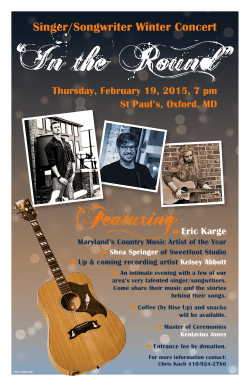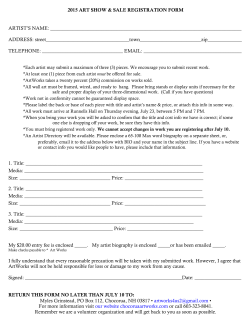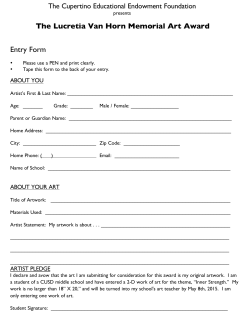
Chapter 20 Northern Europe, 1400 to 1500
Chapter 20 Northern Europe, 1400 to 1500 Multiple Choice Select the response that best answers the question or completes the statement. 1. The Well of Moses, sculpted by Claus Sluter, symbolically represented what promise? a. everlasting life c. the monks’ vow of silence b. protection for the peasants d. the return of Christ 2. The first international commercial stock exchange was established in __________. a. Paris c. London b. Amsterdam d. Antwerp 3. The calendar pictures of Les Très Riches Heures represent the _______________ in terms of the associated seasonal tasks. a. twelve months c. zodiac b. twelve occupations d. astrological signs 4. Philip the Bold’s largest artistic enterprise was the __________________. a. Dijon Cathedral c. Chartreuse de Champmol b. Arras Tapestry factory d. Bruges Cathedral 5. In Broederlam’s Annunciation and Visitation, it has been suggested the rotunda, which appears in the scene, represents the ____________________. a. Old Testament c. New Testament b. Gospel of Luke d. Gospel of John 6. The ________ controlled the Flemish artists’ profession. a. Confraternity of St. Luke c. guilds b. Bourse d. city council 7. A substantial number of women were registered in the art guilds of __________. a. Dijon c. Bruges b. Antwerp d. Ghent 8. Emerging capitalism and greater urban prosperity led to a growing interest in which of the following. a. secular portraiture c. personal devotional diptychs b. polyptych altarpieces d. endowing small chapels 7 9. __________ artists were the first to employ oils extensively. a. French c. Flemish b. Italian d. German 10. When the Ghent Altarpiece is opened, it reveals an image of ___________________. a. Renaissance humanism c. humanity’s Redemption b. Byzantine icons d. secular portraiture 11. In the Ghent Altarpiece, the Lamb symbolized the ______________________. a. sacrifice of Abraham c. Old Testament b. sacrificed Son of God d. Gospel of John 12. Rogier van der Weyden’s Deposition sums up his ________________. a. late style c. middle style b. Florentine style d. early style 13. In the Last Supper from the Dirk Bouts Holy Sacrament altarpiece, the orthogonals converge above the head of Christ to form which of the following. a. a halo c. multiple vanishing points b. a single vanishing point d. a reference for Judas 14. Hans Memling specialized in images of the ___________. a. Trinity c. Crucifixion b. Holy Family d. Madonna 15. Robert Campin’s (Master of Flémalle) Mérode Altarpiece included accessories, furniture, and utensils in his work because they could also function as ______________________. a. religious symbols c. guild advertising b. donor symbols d. background 16. The intersection of the secular and the religious can be seen in the Flemish painting __________________________by Jan van Eyck. a. Giovanni Arnolfini and His Bride c. Ghent Altarpiece b. Man in a Red Turban d. Bruges Madonna 17. During the Hundred Years’ War anarchy and a weakened French monarchy allowed a group of duchies to rise and challenge the power of the king, the strongest of these was _____________. a. Duchy of Normandy c. Duchy of Aquitaine b. Duchy of Toulouse d. Duchy of Burgundy 18. The Swiss artist ___________ showed great skill in the study of water effects. a. Rogier van der Weyden c. Martin Schongauer b. Konrad Witz d. Stephen Lochner 8 19. The art of _____________ developed rapidly with the invention of moveable type and widespread availability of paper. a. sculpture c. printmaking b. panel painting d. manuscript painting 20. Jan van Eyck’s ___________is a completely secular portrait. a. Man in a Red Turban c. Portrait of a Lady b. Giovanni Arnolfini and His Bride d. ′Etienne Chevalier Slide Questions A. Les Très Riches Heures January (Figure 20-15) 21. 22. 23. 24. B. Ghent Altar Closed (Figure 20-5) 25. 26. C. How does this work define 15th century Flemish style? How does the artist use allegory to inform the viewer? Who is the artist? Virgin with Saints and Angels from St. John Altarpiece (Figure 20-14) 30. 31. E. How does this work combine the secular and the religious? What is the medium? Giovanni Arnolfini and His Bride (Figure 20-1) 27. 28. 29. D. How does this work conform to the court of the Duc de Berry? How does this theme conform to 15th century French style? What was the purpose of this work? Who was the artist? How does this work express the Flemish style? How does the artist conform to that style? Saint Anthony Tormented by Demons (Figure 20-22) 32. 33. 34. 35. How does this work express innovation? How does the artist use the technique? How does the work express 15th German style? What is the purpose of this work? Short Answer 36. What is a Book of Hours? 37. Describe the Carthusian order. 9 38. What medieval pictorial conventions does Broederlam employ? 39. What was the function of an altarpiece? 40. Define polyptych. 41. How did the Ghent Altarpiece function? 42. Who was Tommaso Portinari? 43. Who were the primary German patrons during the fifteenth century? 10 ANSWERS Multiple Choice 1. A page 520 2. D page 519 3. A page 533 4. C page 520 5. A page 522 6. C page 528 7. C page 528 8. A page 524 9. C page 523 10. C page 524 11. 12. 13. 14. 15. 16. 17. 18. 19. 20. B page 524 D page 527 B page 530 D page 531 A page 522 A page 524 D page 532 B page 536 C page 537 A page 526 Slide Questions A. 21. It is rich and informative of the court itself; the image shows the Duke at his court receiving guests. This image provides the viewer with a glimpse into court life. Page 533 22. It echoes the formal and rich style of the French 15th century. Pages 532533 23. It is a prayer book that could be used throughout the day. In addition it also contained a calendar for the feast days and additional prayers and litanies. Page 533 24. There were three brothers, Pol, Hennequin, and Herman Limbourg. They died before completing the Book which another court illustrator finished 70 years after their deaths. Pages 532-533 B. 25. 26. C. 27. 28. The inclusion of the donors, Jodocus Vyd and his wife Isabel Borluut, on the bottom portion of the closed altarpiece allows them to participate fully and completely in the devotion. The artist has linked them to Sts. John the Baptist and Apostle, the precursor and the writer of the gospel detailing Salvation and Redemption (it is also likely the Baptist was Vyd’s patron saint), and directly above the couple is the promise of Salvation and Redemption in the form of the Annunciation. Pages 522 Oil on panel (wood). Page 523 It combines references to religious and secular themes. In this work the artist has created a portrait and also a document that might be a visual marriage certificate or a visual “power of attorney” (recent scholarship). The artist has successfully created an image of an important Bruges household. Pages 524-525 The work is replete with allegorical symbols. The everyday household 11 29. D. 30. 31. E. 32. 33. 34. 35. items are transformed into alternate meanings: the single candle in the chandelier is a reference to God (a reference that is repeated in the mirror); the clogs indicate the couple is in the Divine Presence; the small dog is a reference to fidelity. These allegorical references and the others would have been understood by the 15th century viewer. Pages 524-525 Jan van Eyck. Page 524 It is rich both in textures and themes. It is devotional and secular, and it unites luxuriant textures with a religious devotional theme with excellent technical execution. Pages 532 Hans Memling uses rich color to bring a luxurious texture to the work; he has balanced the composition so it can be read easily. Pages 532 The medium of engraving replaced the woodcut as a more facile process. It allowed for book illustrations and single prints to reach a wider segment of the population. Page 538 Martin Schongauer was a master at this medium. He was able to create distinctions between tonal values and textures by using hatching (his development) to describe form. Page 538 It expresses German piety as well as the secular interest in more economically feasible religious works. Page 538 Single sheet print (available to a broader population and more cheaply produced). Page 538 Short Answer 36. A book used for reciting prayers. The center piece was the Office of the Blessed Virgin to be read privately at seven set times during the day. Page 533 37. It consisted of monks who devoted their lives to solitary living and prayer. Page 520 38. A staid treatment of the figures, halos, and flat gold background. Page 522 39. A backdrop for the celebration of the Mass, teaching church doctrine, visually encouraging piety, assisted in ensuring eventual salvation, and promoting greater devotion among the faithful. Pages 520-521 40. Hinged multi-paneled paintings. Page 521 41. As the liturgical centerpiece of the endowment established in the chapel Vyd and Borluut built in the local church dedicated to Saint John the Baptist (now Saint Bavo Cathedral). Page 522 42. An Italian ship owner, Medici agent, and patron of the arts. Page 530 43. The flourishing middle class, wealthy merchants, and clergy. Page 534 12
© Copyright 2025









